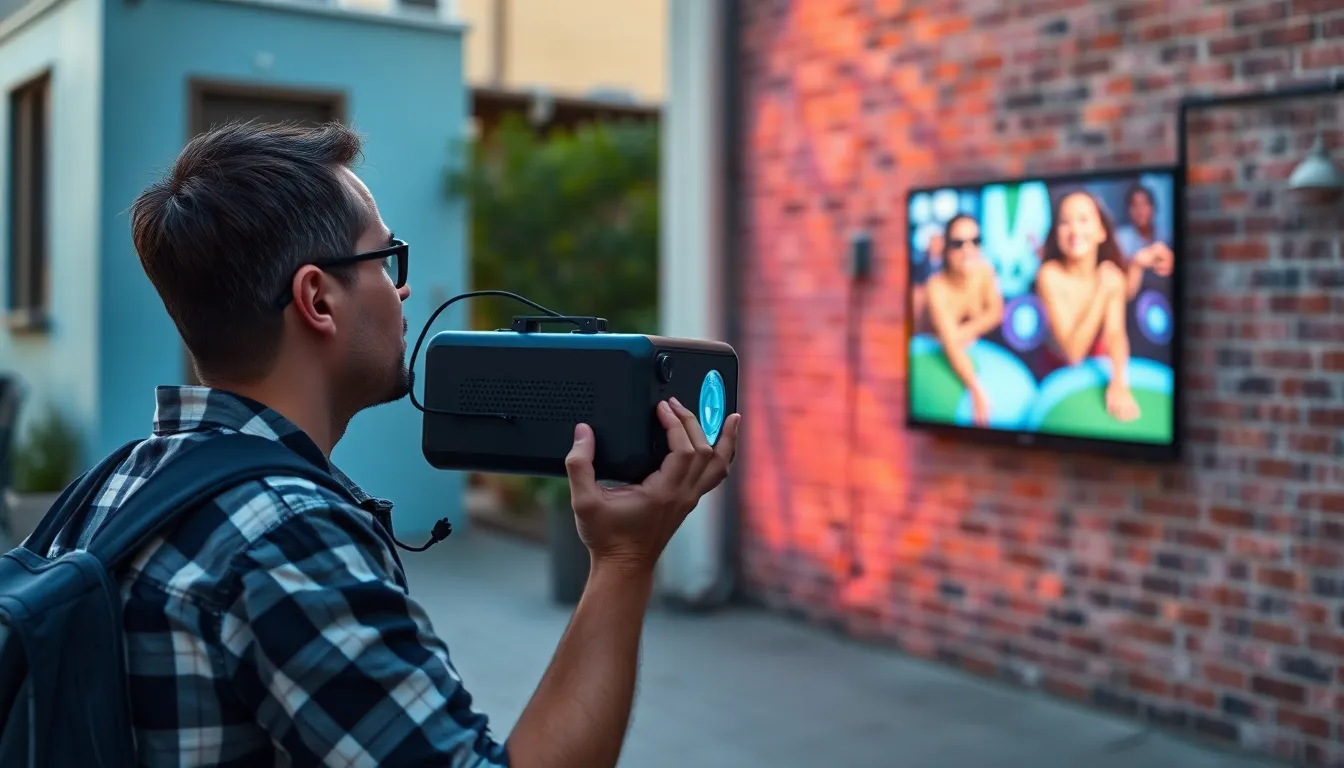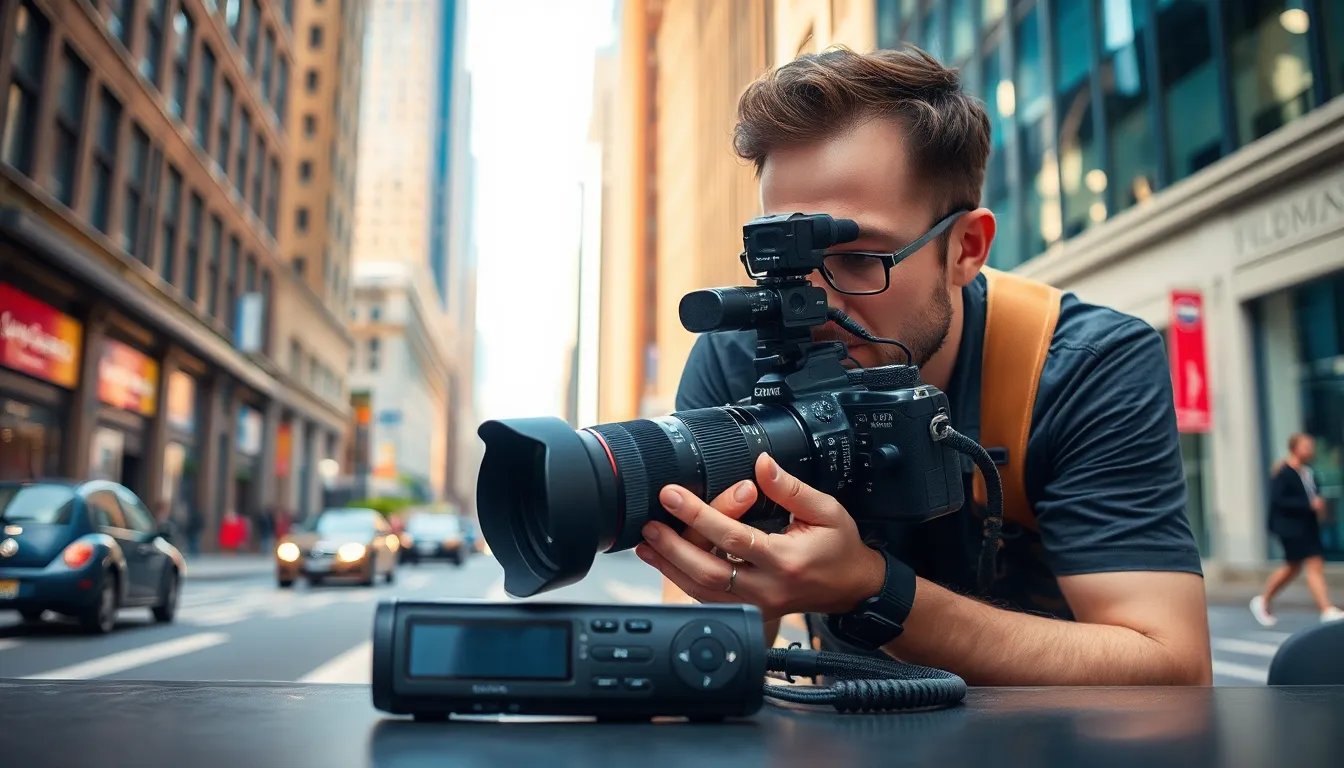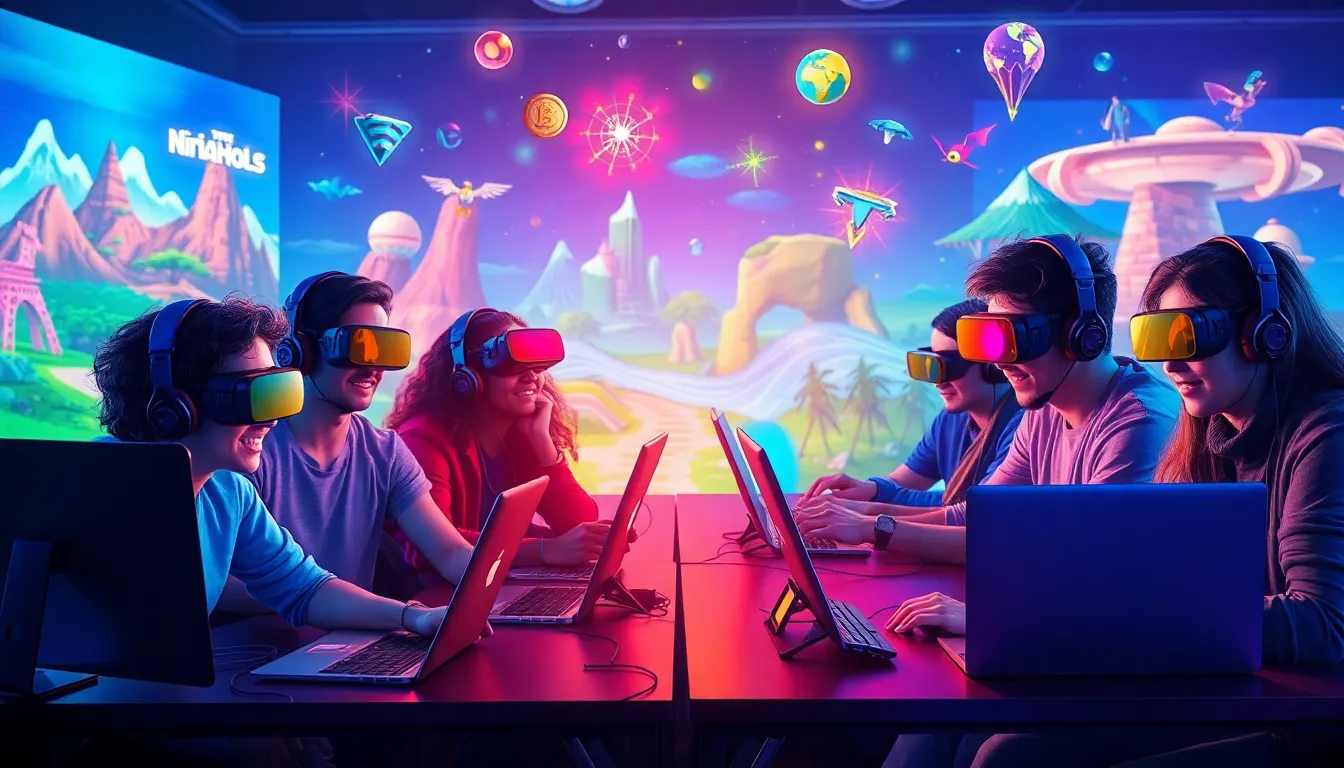Table of Contents
ToggleImagine transforming any surface into a vibrant display with just a flick of your wrist. Wearable projectors are revolutionizing the way people interact with visuals, merging convenience with cutting-edge technology. These compact devices are not just for tech enthusiasts; they’re becoming essential tools for presentations, entertainment, and creative expression.
As they shrink in size and expand in functionality, wearable projectors offer a portable solution for on-the-go lifestyles. Whether it’s projecting a movie during a camping trip or presenting ideas in a meeting, these gadgets provide flexibility that traditional projectors can’t match. With advancements in battery life and image quality, the future of wearable projectors looks brighter than ever.
Overview Of Wearable Projectors
Wearable projectors represent an innovative advancement in portable display technology. These devices can instantly convert any surface into an interactive screen, making them invaluable for diverse settings.
Key Features
- Portability: Wearable projectors are lightweight and compact, allowing users to easily carry them. Their small size makes them suitable for travel and outdoor use.
- Ease of Use: These projectors often include user-friendly interfaces and wireless connectivity, enabling quick setup and seamless streaming from devices.
- Versatility: Wearable projectors can adapt to various applications, such as business presentations, gaming, and home entertainment, making them functional across multiple environments.
Technological Advancements
- Image Quality: Recent models offer enhanced resolution, with some projecting images in HD and beyond, providing clearer and sharper visuals.
- Battery Life: Improved battery technology extends usage time, allowing for uninterrupted viewing and presenting without frequent recharging.
- Smart Features: Many wearable projectors integrate smart technology, enabling compatibility with smartphones, tablets, and smart home systems for an integrated experience.
Market Trends
The increase in demand for portable and multifunctional devices drives innovation in the wearable projector market. Users prioritize convenience and flexibility, leading manufacturers to focus on developing more advanced features, such as touch interactivity and augmented reality capabilities.
Wearable projectors are paving the way for a new era of mobile presentations and entertainment, enhancing user experiences through innovative and adaptable technology.
Key Features Of Wearable Projectors

Wearable projectors stand out for their innovative features that enhance usability and performance. Key characteristics include portability, design, image quality, and resolution.
Portability and Design
Portability defines wearable projectors, as they typically weigh less than one pound. Compact designs ensure these devices fit easily into pockets or bags. Manufacturers prioritize lightweight materials and ergonomic shapes, making them user-friendly for extended periods. Many models incorporate adjustable stands, enabling flexible positioning on various surfaces. This adaptability enhances the viewing experience, allowing users to project content on walls, ceilings, or even outdoor environments.
Image Quality and Resolution
Image quality significantly impacts user satisfaction with wearable projectors. Many devices support resolutions up to 1080p, delivering sharp, vibrant images. Advanced projection technologies, such as DLP and LCD, contribute to increased brightness and clarity. Some projectors feature built-in image stabilization, ensuring that projected images remain steady, even on uneven surfaces. Furthermore, contrast ratios often reach 1000:1 or higher, enhancing color depth and detail. Enhanced brightness levels, ranging from 150 to 1000 lumens, guarantee usability in various lighting conditions, making these projectors versatile for indoor and outdoor settings.
Popular Wearable Projector Models
Numerous wearable projector models cater to different needs and preferences. This section examines two standout models, detailing their features and specifications.
Model A: Features and Specifications
Model A is designed for versatility and portability. It weighs approximately 0.8 pounds, making it easy to transport. Key features include:
- Resolution: Supports 1080p HD resolution for crisp and clear images.
- Brightness: Offers a brightness of 300 ANSI lumens, suitable for various environments.
- Battery Life: Equipped with a rechargeable battery lasting up to 4 hours on a full charge.
- Connectivity: Features HDMI and USB-C ports, ensuring compatibility with laptops, smartphones, and tablets.
- Image Technology: Utilizes DLP technology, which enhances brightness and image clarity.
- Adjustable Stand: Comes with a built-in adjustable stand to allow for flexible positioning on different surfaces.
Model B: Features and Specifications
Model B focuses on enhanced interactivity and user experience. Weighing around 0.9 pounds, it’s portable yet powerful. Notable specifications include:
- Resolution: Supports native 720p with upscaling capabilities to 1080p for high-quality visuals.
- Brightness: Delivers 400 ANSI lumens, performing well even in brighter conditions.
- Battery Life: Lasts up to 5 hours, making it ideal for extended sessions.
- Connectivity: Features wireless connectivity options like Wi-Fi and Bluetooth alongside HDMI ports.
- Augmented Reality: Integrates augmented reality functionalities for immersive user experiences.
- Touch Control: Includes a touch-sensitive interface for easy navigation and control during presentations.
These two models exemplify the innovation within the wearable projector market, catering to various user requirements and setting the stage for enhanced mobile presentations.
Use Cases For Wearable Projectors
Wearable projectors serve diverse functions across various sectors, enhancing experiences in education, entertainment, and more.
Education and Presentations
Wearable projectors benefit educational environments by facilitating interactive learning experiences. They allow educators to project lessons, demonstrations, or multimedia presentations directly onto walls or desks, enabling visual engagement. Students benefit from this technology, as it promotes collaborative learning and group activities. With compatibility for devices like tablets and smartphones, educators can stream content seamlessly for enhanced instruction. Additionally, portable projectors make it easy to host lectures or workshops in unconventional locations, expanding the reach of educational opportunities.
Entertainment and Gaming
Wearable projectors redefine entertainment and gaming experiences by transforming any space into an immersive viewing area. Users can project movies, shows, or gaming graphics onto walls, creating large displays without the need for traditional screens. This portability allows users to enjoy cinematic experiences in parks, backyards, or during travel. Gamers benefit from the enhanced interactivity that wearable projectors offer, as they can engage with friends in multiplayer scenarios. Smart features enable streaming services access, making it convenient for on-the-go entertainment without sacrificing quality or performance.
Wearable projectors are revolutionizing the way users interact with visual content. Their compact design and advanced features make them indispensable tools for both personal and professional use. As technology continues to evolve these devices will only become more capable and versatile.
The ability to project high-quality images in various environments opens up new possibilities for education entertainment and creative expression. With their lightweight nature and enhanced battery life users can easily integrate wearable projectors into their daily routines.
As demand grows manufacturers are likely to continue innovating in this space. The future looks bright for wearable projectors as they redefine the boundaries of portable display technology.







